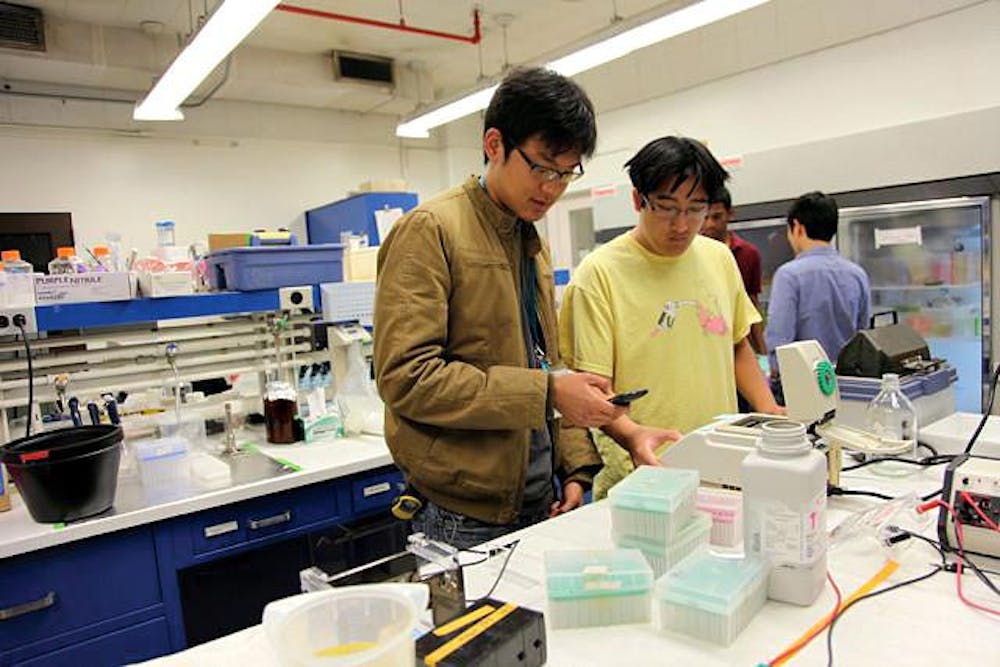"Mars and the moon are lifeboats if anything catastrophic happens on Earth," said Max Song '14. But packing for the move would require Hermione's bottomless bag — there's not much room in the trunk of the spacecraft — or the next best thing: synthetic biology. Instead of packing impossible amounts of fuel, food, medicines and building materials, all space settlers might need could fit into test tubes.
That's the goal of a project being done by a team of nine students from Brown and Stanford as a part of the International Genetically Engineered Machine competition, or iGEM. Since 2004, the competition has fostered undergraduate enthusiasm for synthetic biology, "the science of creating machines from biological parts," according to the team's website. Two weeks ago, at iGEM's Americas Regional Jamboree in Indianapolis, the Brown-Stanford team finished in the top four of 51 teams from all over the Americas and won best presentation. The team will compete in the World Championship Jamboree at MIT Nov. 5.
For this year's project, the team decided to focus on space exploration. "Synthetic biology is the perfect toolkit for space" because genetic code does not take up much space, Song said.
"The chances of an asteroid hitting the Earth are not minute," he said, so it makes sense that scientists take steps to prepare.
For the first part of their project, the team engineered bacteria to make "RegoBricks" created from regolith — sand and dust that can be found on Mars or the moon. The bacteria precipitate calcium carbonate — a chalky substance found in limestone, concrete and cement — which holds together the regolith particles, turning them into a solid substance.
To feed these micro-construction workers, the team designed the "PowerCell." They engineered a strain of sucrose-producing cyanobacteria, blue-green algae, to secrete its sugars. A transport protein exports the sucrose onto media, which can then be used to grow other types of useful bacteria, like E. coli.
Such interdisciplinary research "wouldn't have happened if there hadn't been this mix of amazing students," said Lynn Rothschild, adjunct professor of molecular biology, cell biology and biochemistry. Rothschild stepped up as the team's faculty adviser last year when Professor of Biology Gary Wessel, who previously oversaw the team, went on sabbatical. Rothschild is also a consulting professor of human biology at Stanford, and when she realized Brown's team needed more students, she recruited some from Stanford, which was not planning to field its own team this year.
All of the students spent the summer working at NASA's Ames Research Center in California, where Rothschild is a research scientist, with the Brown students receiving funding from Undergraduate Teaching and Research Awards. Team captain Julius Ho '12 brought to the table his experience from last year's iGEM competition, and the Stanford students brought their planetary science backgrounds. "It was the perfect storm of having NASA, Brown and Stanford together," Rothschild said.
In the month between the regional and world jamborees, the Stanford students have been holed up in the lab, rushing to get more results and data. The Brown students are polishing the presentation.
Song is also working on an online repository of outreach activities organized by iGEM teams to share synthetic biology with the public and is building a network of iGEM alums called "AlumniGEM."
Ho said he is looking forward to next month's competition, when he will have the chance to meet teams from all over the world and learn from their "fascinating" projects.
Undergraduates rarely get the opportunity to craft their own research, which is what makes iGEM unique, Ho said. "Oftentimes, you don't get to have this autonomy in crafting your own research," he said. "We had very supportive faculty advisers, but for the large part, this entire project is built from the ground up by undergraduates," Ho said.
Natalie Villacres is a senior staff writer for The Brown Daily Herald covering the University Hall beat. She previously covered activism for Metro News. Natalie is a sophomore from Queens, NY studying psychology and education.





